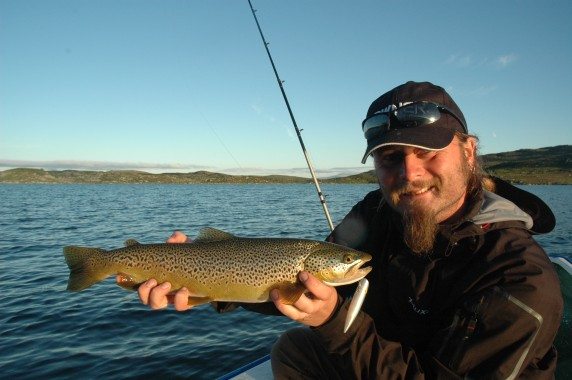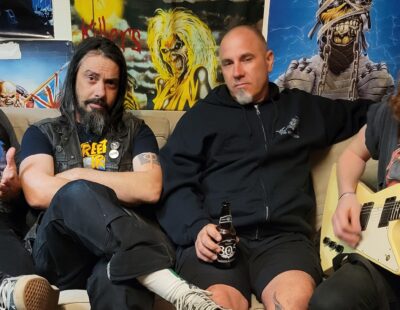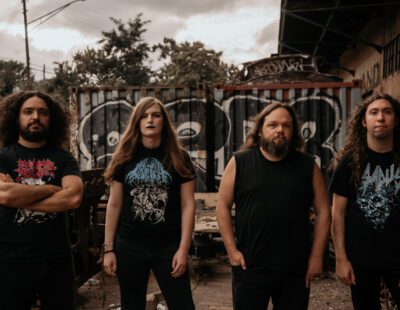When ENSLAVED‘s Grutle Kjellsson and Cato Bekkevold go fishing they don’t fuck around. It’s really not like going down the pond chasing blue gills or Tommy cats; in Norway, even the trout are built super-hench. You might have caught some footage of them catching alligator gar in Texas a few years ago, but you’ll definitely be aware that alongside their official Enslaved duties as bassist/vocalist (Grutle) and drummer (Cato), the pair are specimen anglers, piscatorial assassins. Where Fenriz has hiking and trees to fill his downtime, Grutle and Cato hit the lake or the sea. After derailing pretty much every interview we’ve done by sharing fishing tales, we thought it was a good time to crash the tour bus, pore over some fishing photos and talk angling for real. Some of the Nordic vistas just a 30 minute trip from Cato’s house in Southeast Norway are pretty special too, surely the fishing’s just an excuse to spend more time in isolation, save for the company of deer and heron.https://youtu.be/DaVAVGkEcQw
What is your all-time best fish, size and species?
Cato: For me it was a perch, and it was caught in the Southeast of Norway and weighed about 5lbs. I’ve been fishing for perch since I was born and I’ve caught so many, thousands of them—like 300 on one fishing trip, shit like that. But the small perch are plentiful but the big fish are… 2 kilos is the magic weight, so when I finally got that one it was like, “Wow!” They are so rare. Also the porbeagle shark I caught in Scotland was a pretty good fish. It’s hard to rate, because I have very special feelings for the perch because it has always been there. That’s probably the catch of my lifetime even though it was only 5lbs.
Grutle: For me it’s definitely got to be my biggest zander, or pike-perch. It was 20.2lbs. I’ve been fishing in that lake for so many hours, for so many years, and I’d got some good ones but this one was like finally about 9kg and real fat, and really beautiful. I was fishing in a deep hole. It is up on the wall at my friend’s retail store. I froze it and sent it to him and got it stuffed—up on the wall! It was a beautiful fish. They are beautiful fish, and amazing tasting too, especially the small ones. That’s probably my number one.
That’s the thing with specimen angling; the fish get under your skin. Which fish have became an obsession for you?
Cato: Oh, pike, I would say. Pike, trout, char…
Grutle: Perch! Halibut, and sea trout maybe, and sometimes salmon.
Cato: In some parts of Norway where the sea farms have increased in numbers the population of sea trout has almost diminished—it is probably the sea lice on the fish that kills the small ones, but in some other parts they are plentiful.
What do you fish for when you’re back at home?
Cato: Where I live, there are only three available species; we have Arctic char, brown trout and burbot—that’s like a freshwater cod. I think the burbot is extinct in the British Isles, in the late, late 1960s.
Grutle: They have them in some lakes in Scotland?
Cato: They disappeared some years ago, but I don’t know why. I think it was Chris Yates, the guy who dresses all in tweed and is very much the gentleman fisherman; he came to Norway, to where I live, specifically to catch burbot. To him it was a legend, and it is plentiful where I live.
Grutle: I think they still existed [in the UK] when he was a kid.
One of the best things about a fishing trip is spending time in the great outdoors. You can see some strange sights. What’s the weirdest thing you’ve seen when out fishing?
Grutle: The most exotic place was probably when we were fishing in Victoria, Texas. There was all those alligators and birds of prey, possums, snakes, fire ants, snapping turtles—a lot of snapping turtles…
Cato: Americans! A lot of weird animals, hahaha!
Grutle: And poisonous spiders! They had everything.
Cato: We hooked up with this guide who had a boat for two days fishing. We were supposed to fish the Trinity River but it was too cold so we found a river closer to the coast.
Is the Norwegian seafishing scene is still very healthy?
Cato: Up north it is.
Grutle: in the south the cod population has decreased a lot—I mean they are hard to get nowadays and they used to be really easy. There are still good numbers of ling… In the north there is a healthy population.
Cato: The longliners wiped out the stock locally. I think from the western part of Norway and north it is pretty damned good. I’ve got some pictures from when we were up there trying to fish for halibut and that wasn’t easy; we were bugged by 20, 30 and up to 40lb cod all the time.
Grutle: That was boring. It was too much.
What were you using to catch the halibut?
Cato: Whole coalfish for bait.
Grutle: … And herring as well, mackerel. We used a giant jig-head and bounced it off the seafloor, so it doesn’t matter if the bait is live or dead; that makes the motion.
Cato: You can use 2 to 3lb fish. The most halibut I caught in a day was in May, last year. I got eight, just from drifting with dead herring as bait. There’s got to be movement with the bait—the halibut likes to hunt.
Cato: Here’s Grutle with a nice halibut. It’s his new blanket. It was a bit slimy but it tastes good.
Grutle: It tasted very good.

So here, after much deliberation, are Enslaved’s most metal fish
ALLIGATOR GAR
Cato: It is a very metal fish because the teeth and the scales, and just the general appearance. It has this very primitive lung. It can go up and take a breath of air. Kinda like a tarpon.
Grutle: They’re called the poor man’s tarpon. The local Indians used to use the scales for arrowheads. I’m not kidding; they are so thick. We had some real big ones. The first day we didn’t catch any of them, then SSSSSHHHHWWWWOOOOMMMM! One of them jumped beside the bought. It was bigger than the ones we caught.
What bait did you use for them?
Cato: Carp, buffalo carp—just freelining them.
Grutle: The bait we caught them on was freshly killed carp, which sounds a little bit bizarre to say that in England.
Cato: But over there that there are so many of them they are considered a nuisance.
In Australia, by law you have to kill a carp if you catch it.
NORTHERN PIKE
Grutle: Northern pike, for sure.
Cato: It is the most pure, most uncompromising predator in freshwater.
They can get a bad reputation from gamekeepers who say they destroy trout populations.
Grutle: It depends, the trout and the pike can be part of a perfectly balanced ecossytem.
Cato: In deeper lakes the pike normally inhabits the shallower parts, close to the shore, and well off from the shore you’ll have the trout. They hunt in different ways. One is kind of sneaky, and the other is just rapid speed. You have to have the top predators to keep the whole fish stock under control.
EUROPEAN CATFISH
Grutle: We have to add the European catfish. That’s just a ruthless, legendary motherfucker! That is Europe’s biggest freshwater fish.
Cato: That is one ruthless, uncompromising fish. He caught the biggest, close to Barcelona. They call it the catfish capital of Europe, where the River Ebro and Segre meet, Mequineza. We were fishing in May. It was 30 degrees, sunny.
Grutle: You can fish for them all year round, but in the summer it gets too hot. You can use anything that is smaller than it for bait—eel, pike, carp, pellets. They can eat anything. The first time we used eel but the second time we used halibut pellets, like a string of super-sized boilies, and we tied that to big stones, rocks. It was just like a big upgraded bolt rig for carp fishing.
Cato: The principles were the same.
Cato: I stay south-east of Trondheim, very close to the Swedish border. 10 minutes driving and 20 minutes walking and you’re there. That’s Grutle with the biggest fish of the trip, a really nice trout.

TROUT/SALMON
Grutle: I would say the good old trout.
Cato: It gets up there and jumps. It’s kinda outspoken, and it’s very versatile too. I think it is the only species in Norway that you can find all over the country.
Grutle: Have you seen an underwater picture of a 20lb trout when he is about to breed? You’d be afraid! Haha! The big males are…
Cato: When they’re spawning big males are quite aggressive. They made a film made in Norway with big, 20kg salmon with the hook jaw, big teeth, and he was teaming up with this female salmon, working in pairs in this river; you had the smaller salmon coming into the stream trying to spread their sperm and eventually the big salmon get angry and actually killed the other salmon just with a bite. They’ve got that on film, an underwater film that took two or three years to make. It is survival of the fittest and testosterone.
Grutle: We should add the salmon then, right?
Cato: Yup, it’s big and it’s powerful.

SIX-GILLED SHARK
Cato: There’s a picture of me fighting one [above]. This is what we can call a swimming bucket, because we were using 10lb fish for bait! That’s a six-gilled shark from Ascension Island in the mid-Atlantic. It’s about 8 degrees south of the Equator. If you go straight west you end up in Brazil. If you go east you end up in Angola.
WHITE STURGEON/BLUEFIN TUNA
Grutle: We’ve never been fishing for it but you can add it to the list. It’s the white sturgeon, or the white whale!
Cato: And you can add giant bluefin tuna tuna from the coast of Massachusetts or Canada. That is rated as the ultimate sportfish just because of the size and the power.
Grutle: Isn’t it the most powerful game fish?
Cato: Yeah, if you took the bluefin tuna and any other game fish it could tow it by the tail. I’ve seen one caught in Croatia but that was my mate. It took my bait but just left the bait where the hook was. It was so close. I even heard a click in my reel.
For the record, the Deciblog practises catch-and-release, and would have the giant trevally as our most metal fish.






